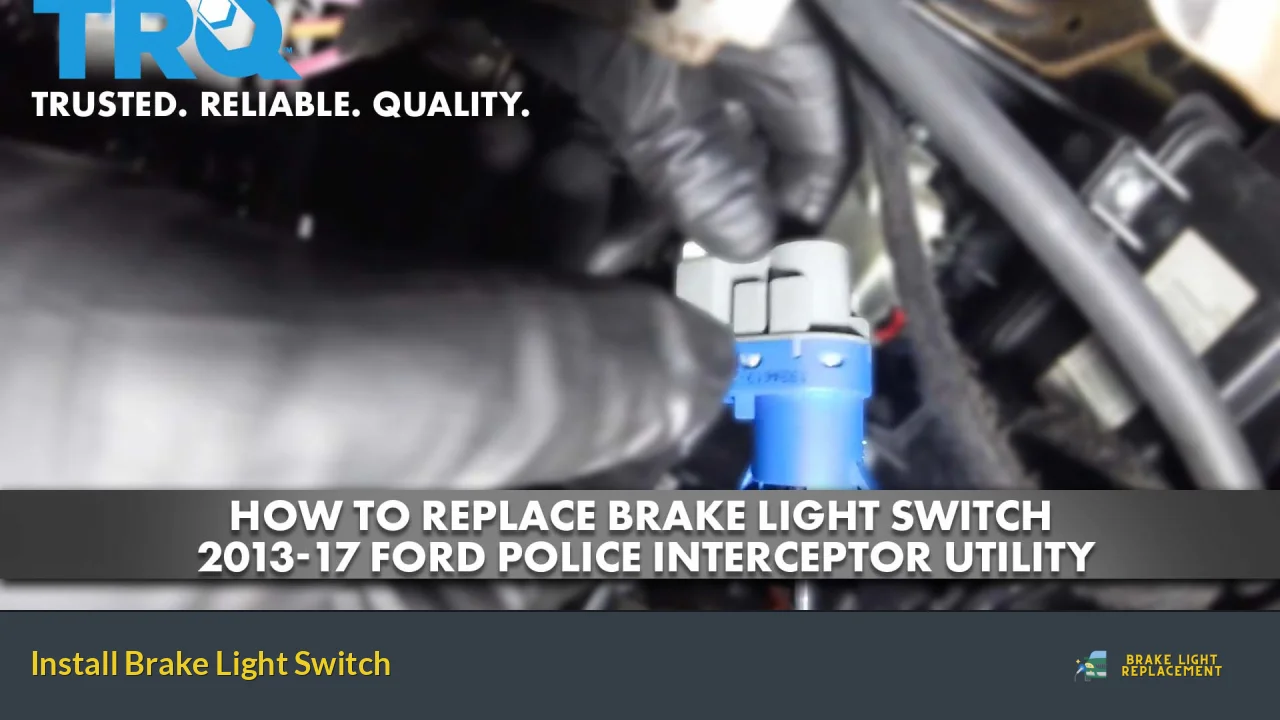Are you looking to install a brake light switch in your vehicle? It’s an essential safety feature that ensures the brake lights illuminate when you press the brake pedal, alerting drivers behind you of your intentions on the road. In this article, we’ll guide you through the process of installing a brake light switch, empowering you to take control and make your car safer.
First things first, let’s gather the necessary tools for the job. You’ll need a new brake light switch, a set of wrenches or pliers, and electrical tape. Ensure that you have the correct replacement switch for your specific vehicle model.
To begin the installation, locate the brake pedal mechanism under the dashboard. You should be able to find the existing brake light switch attached to it. Carefully disconnect the wiring harness connected to the switch by gently pulling it apart. Take note of the wire colors and how they are connected, as this will help you during the reinstallation process.
Next, use your wrench or pliers to loosen and remove the mounting bolts holding the old switch in place. Once removed, detach the old switch from the brake pedal mechanism. Take a moment to clean any dirt or debris around the area to ensure a smooth installation.
Now, it’s time to install the new brake light switch. Align the switch with the brake pedal mechanism and secure it in place using the mounting bolts. Make sure the switch is positioned correctly and firmly tightened.
Once the switch is securely installed, reconnect the wiring harness. Match the wire colors to their respective connections, ensuring a snug fit. To provide added insulation and protection, wrap the wired connections with electrical tape.
Congratulations! You’ve successfully installed a new brake light switch in your vehicle. Before calling it a day, test your brake lights by pressing the brake pedal. Ensure that the lights illuminate promptly and brighten as you apply pressure. If everything looks good, pat yourself on the back for a job well done!
Remember, maintaining functional brake lights is crucial for your safety and the safety of those around you. If you encounter any difficulties during the installation process or are unsure about any steps, it’s always best to consult a professional mechanic for assistance.
So go ahead, take these steps and equip your car with a new brake light switch. Drive with confidence, knowing that you’ve taken an important step towards ensuring a safer journey for you and your fellow road users. Stay safe out there!
Innovative Brake Light Switch Installation Method Revolutionizes Vehicle Safety

Are you tired of traditional brake light switch installations that can be cumbersome and time-consuming? Well, get ready to be amazed because a revolutionary method has arrived that will completely change the way you think about vehicle safety. Say hello to the innovative brake light switch installation method that is set to revolutionize the automotive industry.
Picture this: you’re driving down the road, and suddenly you need to hit the brakes. In that critical moment, the brake light switch plays a crucial role in alerting the drivers behind you. Traditionally, installing a brake light switch required complex wiring and meticulous adjustments. But now, thanks to this game-changing installation method, the process becomes easier than ever before.
The new method takes advantage of cutting-edge technology and simplifies the entire process. No more struggling with intricate wiring diagrams or spending hours fine-tuning the switch. With this innovative approach, all it takes is a few simple steps to install the brake light switch seamlessly.
Imagine being able to install the switch effortlessly, just like snapping together puzzle pieces. This method utilizes a user-friendly interface that anyone, regardless of their technical expertise, can easily navigate. By eliminating the need for complicated procedures, it saves both time and effort, allowing you to focus on what truly matters: your safety on the road.
But the benefits don’t stop there. This groundbreaking installation method is not only user-friendly but also highly reliable. It ensures a secure connection between the brake light switch and the vehicle’s electrical system, minimizing the risk of malfunction. You can drive with peace of mind, knowing that your brake lights will work flawlessly when you need them the most.
The innovative brake light switch installation method is a game-changer in the world of vehicle safety. Its simplicity, reliability, and efficiency make it a must-have for every driver. Say goodbye to complicated installations and hello to a new era of effortless brake light switch installations. Buckle up and get ready to experience the future of automotive safety firsthand. Your journey towards enhanced road safety starts here.
How Installing a Brake Light Switch Can Prevent Rear-End Collisions

Introduction:
Have you ever wondered how a small component like a brake light switch can make a huge difference in preventing rear-end collisions? Well, let me tell you, this unassuming device plays a vital role in ensuring road safety and avoiding accidents. In this article, we’ll explore the importance of installing a brake light switch and how it works to prevent those dreaded rear-end collisions.
The Power of Visibility:
Picture this scenario: you’re driving along, maintaining a safe distance from the vehicle in front of you when suddenly, they hit the brakes. Without functioning brake lights, how would you know they’re slowing down? This is where the brake light switch steps in as a hero. By automatically activating the brake lights when you press the pedal, it alerts drivers behind you, giving them crucial information about your intention to decelerate or stop.
Preventing Rear-End Collisions:
Rear-end collisions often occur due to a lack of communication between drivers. When a vehicle’s brake lights don’t illuminate, it becomes challenging for others on the road to anticipate its movements. This delay in response time can lead to disastrous consequences. However, by installing a brake light switch, you enhance your car’s visibility, significantly reducing the risk of rear-end collisions. It acts as a clear signal to fellow drivers, enabling them to react promptly and adjust their speed accordingly.
How Does It Work?
The brake light switch functions in a straightforward manner. It is typically located near the top of the brake pedal arm, allowing it to detect when the pedal is depressed. When pressure is applied, the switch activates the circuit that powers the brake lights, causing them to shine brightly. This immediate illumination gives drivers behind you ample time to react, maintaining a safe distance and preventing potential accidents.
Conclusion:
In summary, the installation of a brake light switch may seem like a minor detail, but its impact on preventing rear-end collisions is significant. By ensuring your brake lights function properly, you contribute to better communication between drivers, enhancing overall road safety. So, next time you step on the brake pedal, remember the crucial role that this small yet powerful switch plays in keeping everyone safe on the road. Stay vigilant, and prioritize installing a functional brake light switch for a safer driving experience.
Expert Tips: Step-by-Step Guide to Installing a Brake Light Switch Yourself
Are you tired of spending time and money at the auto repair shop for simple fixes? Installing a brake light switch is one task that you can easily handle on your own. In this step-by-step guide, we will walk you through the process, providing expert tips to ensure a successful installation.
Firstly, let’s gather the necessary tools. You’ll need a wrench, a screwdriver (Phillips or flathead depending on your vehicle), electrical tape, and a new brake light switch compatible with your car make and model. Once you have these tools ready, it’s time to get started.

Step 1: Locate the brake pedal switch. This switch is usually positioned above the brake pedal arm, near the top. You might need to remove any panels or covers obstructing your view. Once you spot it, disconnect the electrical connector attached to the switch.
Step 2: Remove the old switch. Using a wrench, carefully loosen and unscrew the mounting bolts holding the switch in place. Gently pull the switch away from the pedal assembly and set it aside.
Step 3: Prepare the new switch. Take your new brake light switch and compare it with the old one to ensure compatibility. Adjust the length if needed, so it matches the original switch. Secure it in place using the mounting bolts and tighten them with a wrench.
Step 4: Connect the electrical wires. Reattach the electrical connector to the new switch. Make sure it fits snugly and use electrical tape to secure any loose connections. This step is crucial to ensure proper functioning of your brake lights.
Step 5: Test the brake lights. Get behind the wheel and press the brake pedal. Check if the newly installed brake light switch activates the brake lights as intended. If they don’t illuminate or flicker, recheck the electrical connections and adjust the switch if necessary.
Congratulations! You’ve successfully installed a brake light switch on your own. Remember, safety should always be a priority, so it’s important to test the brake lights thoroughly before hitting the road. With this simple DIY task under your belt, you can save time and money while enjoying the satisfaction of tackling automotive projects yourself.
By following this step-by-step guide, you can confidently replace your brake light switch without any hassle. Remember, if at any point you feel unsure or uncomfortable, don’t hesitate to consult a professional mechanic. Happy installing!
New Study Reveals the Importance of Properly Installed Brake Light Switches
Are you aware that a tiny device under your foot could be a lifesaver? A recent groundbreaking study has shed light on the crucial importance of having properly installed brake light switches in our vehicles. This discovery has far-reaching implications for road safety and emphasizes the need for regular maintenance and attention to this seemingly insignificant component.
Picture this: You’re driving down a busy street, and suddenly the car ahead of you slams on its brakes. In that split second, your instinct is to react quickly and step on the brake pedal. But what if your brake lights fail to illuminate, leaving the driver behind you clueless about your intentions? The consequences can be catastrophic.
According to the study conducted by renowned automotive experts, a staggering number of accidents occur due to faulty or improperly installed brake light switches. These small devices are responsible for activating the brake lights when you press the pedal, alerting other drivers to your actions on the road.
The research team discovered that many brake light switch failures result from poor installation or neglecting routine checks. Over time, wires may become loose or worn, affecting the switch’s functionality. Even a minor misalignment can disrupt the electrical connection and render the brake lights inoperative.
The implications of these findings are profound. By ensuring proper installation and regular maintenance of brake light switches, we can significantly reduce the risk of rear-end collisions and other accidents caused by inadequate signaling. It’s like having a reliable communication system between drivers, fostering a safer driving environment for everyone on the road.
To put it simply, a well-installed brake light switch acts as a guardian angel, silently working to protect you and those around you. Just like how a lighthouse guides ships safely through treacherous waters, properly functioning brake lights guide fellow motorists, providing them with essential information to make split-second decisions.
